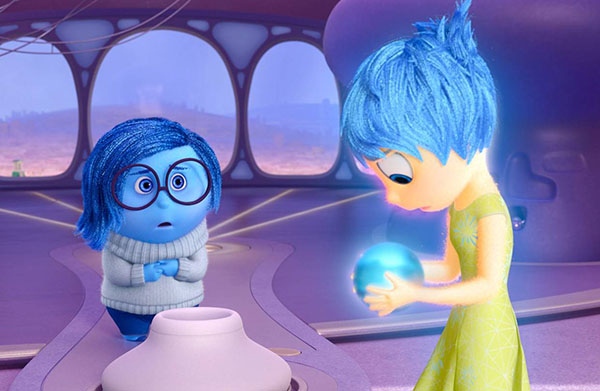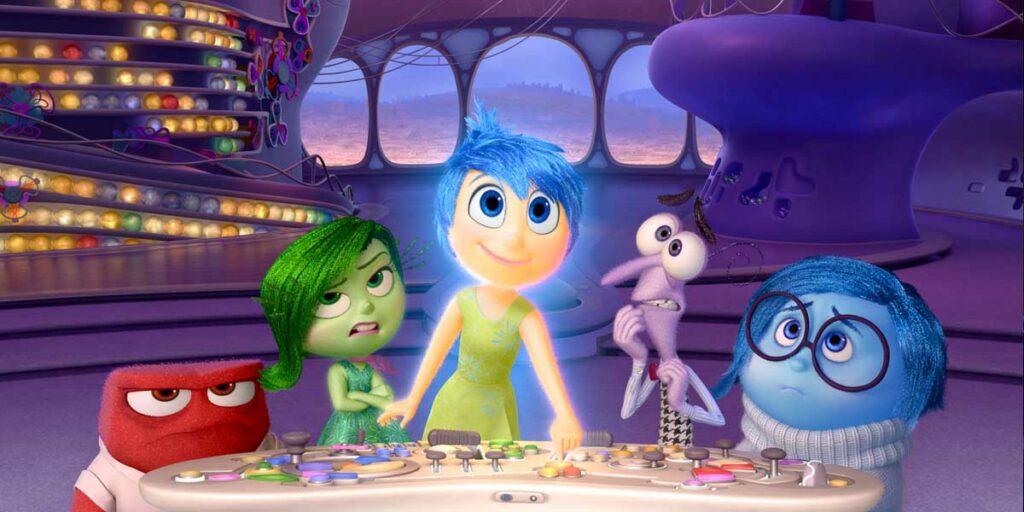A unique portrayal of adolescence, Inside Out portrays a sentimental story with remarkable emotional intelligence.
In July 2015, almost precisely eight years ago, Inside Out came out in cinemas. Similarly to Pixar’s newest animated movie Elemental, Inside Out initially debuted at the Cannes Film Festival in 2015 outside the competition, to then come out worldwide in June of the same year. Funnily enough, that is not the only connection between the two Pixar movies. Inside Out is set in San Francisco and, thus, features the famous Golden Gate Bridge; a very similar bridge to the San Francisco landmark is also present in Elemental City, as shown in one of the beginning shots of Elemental.
Inside Out also proves that a film can be entertaining and successful without necessarily focusing on a love story or having a love interest for its female protagonist. The film follows 11-year-old Riley (Kaitlyn Dias) in the delicate period of adolescence, offering us an insight into Riley’s head in the form of basic emotions: Joy (Amy Poehler), Sadness (Phyllis Smith), Fear (Bill Hader), Anger (Lewis Black), and Disgust (Mindy Kaling). The anthropomorphic emotions, led by Joy, guide her through this life-changing period from the headquarters in Riley’s mind as they control her reactions and categorize her memories.
At the beginning of the movie, Riley and her family move to San Francisco because of her father’s job. This brings Sadness to the forefront, inadvertedly leading to Joy and Sadness embarking on an adventure through Riley’s mind as she goes through significant changes. Meanwhile, Anger, Fear, and Disgust are left at Headquarters without their leader, trying their best to help Riley make some happy memories after the move. But their actions have consequences on the girl’s “personality islands,” and this also affect Joy and Sadness, who fall into Riley’s “memory dump” as a result and risk being completely erased from her mind. As we follow our protagonist’s emotions on their journey, we are shown how what they do affects her life and personality, and ultimately come to understand why we need each and every one of these emotions.

Inside Out’s very own premise may very well be the most impressive element of the film. While the idea of showing inanimate objects – or in this case, emotions – having feelings is not a new one from Pixar, as the trend that started with the Toy Story franchise can prove, the physical representation of emotions and mental states is quite striking. Showing our emotional states, or at least the most basic ones, as anthropomorphic figures with their own feelings and thoughts is certainly original. Portraying complex human emotions as actual beings is something I have not seen done on screen before and a clever way to humanize and make sense of our feelings.
Most strikingly, the portrayal of mental health in Inside Out is still extremely relevant today. At the beginning of the film, Joy seems to be in charge of all the other emotions, but we soon realize that all of them are needed in Riley’s life. While Sadness initially has a marginal role, overshadowed by an overzealous Joy, it is the former who is in charge of Riley’s mind during a key moment with her family, which soon turns into an important memory for Riley. Inside Out manages to show us that Joy and Sadness are both important in our lives, as they work together in Riley’s mind to create core memories, those sets of memories that hold particular emotional value, thus shaping who we are.
When Joy and Sadness are fair away in the depths of Riley’s mind and the other emotions are in charge, Riley cannot be happy anymore. As she decides to run away and go back to Minnesota, the emotions cannot make her feel anything anymore, as the control panel they use inside Riley’s head seems frozen. This hints at a much more complex phenomenon, that of depression: Riley is not just sad, as she had been earlier in the film, but she’s seemingly incapable of feeling anything at all, until Joy and Sadness come back to Headquarters.
It is not easy to depict something at complex as depression, or something that resembles depression in Riley’s case. But Inside Out somehow makes sense of it, as we can physically see that it is caused by the Fear, Anger, and Disgust not being able to operate the control panel anymore. What’s also significant is that there is no judgement from the film, which portrays this as a part of Riley’s life that she is eventually able to overcome. As such, the film also succeeds in portraying the sensitive and fragile period of adolescence with tenderness and dignity, while also staying true to the reality of how confusing and unsettling this stage of life can be.
Even if Riley is thoroughly explored, I wish her parents were given a similar depth. While we do see the so-called emotional headquarters of both Mom and Dad in the movie, this happens briefly and only raises further questions. For example, what made Anger be the leading emotion in Dad’s head? And how do emotions and memories grow and evolve into adulthood? Admittedly, this was not the theme Inside Out wanted to cover, but it would definitely make for an interesting sequel.
While touching upon these deep and emotional topics, the film manages to have light-hearted and fun moments, making it an enjoyable, and only sometimes moving, watch. Shining a light on such important yet somewhat mundane topics is perhaps what makes Inside Out such a beloved and universally relatable movie. Most of all, this film is a testament to the amazing things that can be done when we dare to trust an original idea, especially when it has so much heart and passion, as this movie clearly does. This is something that is desperately needed in an era in which big studios tend to rely on the safety of remakes and retellings.
Inside Out is now available to watch on digital and on demand.

